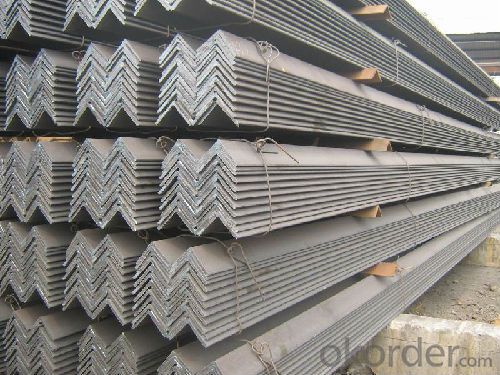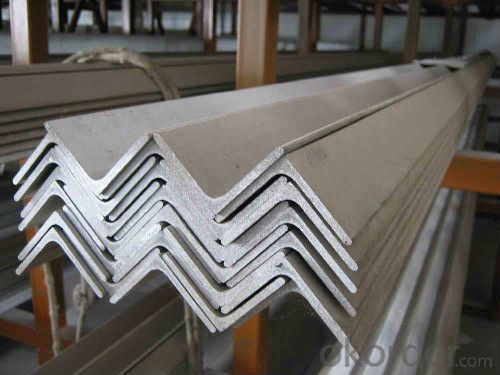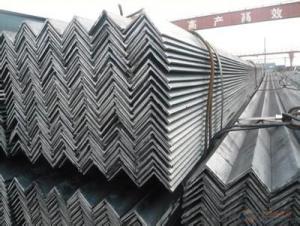High Quality Hot Rolled Angle Steel GB Q235
- Loading Port:
- Tianjin
- Payment Terms:
- TT or LC
- Min Order Qty:
- 25 m.t.
- Supply Capability:
- 20000000 m.t./month
OKorder Service Pledge
OKorder Financial Service
You Might Also Like
Product Description:
OKorder is offering high quality High Quality Hot Rolled Angle Steel GB Q235at great prices with worldwide shipping. Our supplier is a world-class manufacturer of steel, with our products utilized the world over. OKorder annually supplies products to European, North American and Asian markets. We provide quotations within 24 hours of receiving an inquiry and guarantee competitive prices.
Product Applications:
According to the needs of different structures, Angle can compose to different force support component, and also can be the connections between components. It is widely used in various building structures and engineering structures such as roof beams, bridges, transmission towers, hoisting machinery and transport machinery, ships, industrial furnaces, reaction tower, container frame and warehouse etc
Product Advantages:
OKorder's High Quality Hot Rolled Angle Steel GB Q235 durable, strong, and resist corrosion.
Main Product Features:
· Premium quality
· Prompt delivery & seaworthy packing (30 days after receiving deposit)
· Corrosion resistance
· Can be recycled and reused
· Mill test certification
· Professional Service
· Competitive pricing
Product Specifications:
Manufacture: Hot rolled
Grade: Q195 – 235
Certificates: ISO, SGS, BV, CIQ
Length: 6m – 12m, as per customer request
Packaging: Export packing, nude packing, bundled
Sizes: 25mm-250mm | ||||||||||||
a*t | ||||||||||||
25*2.5-4.0 | 70*6.0-9.0 | 130*9.0-15 | ||||||||||
30*2.5-6.6 | 75*6.0-9.0 | 140*10-14 | ||||||||||
36*3.0-5.0 | 80*5.0-10 | 150*10-20 | ||||||||||
38*2.3-6.0 | 90*7.0-10 | 160*10-16 | ||||||||||
40*3.0-5.0 | 100*6.0-12 | 175*12-15 | ||||||||||
45*4.0-6.0 | 110*8.0-10 | 180*12-18 | ||||||||||
50*4.0-6.0 | 120*6.0-15 | 200*14-25 | ||||||||||
60*4.0-8.0 | 125*8.0-14 | 250*25 | ||||||||||
FAQ:
Q1 How do we guarantee the quality of our products?
A1 We have established an advanced quality management system which conducts strict quality tests at every step, from raw materials to the final product. At the same time, we provide extensive follow-up service assurances as required.
Q2 How soon can we receive the product after purchase?
A2 Within three days of placing an order, we will begin production. The specific shipping date is dependent upon international and government factors, but is typically 7 to 10 workdays.
Q3 What makes stainless steel stainless?
A3 Stainless steel must contain at least 10.5 % chromium. It is this element that reacts with the oxygen in the air to form a complex chrome-oxide surface layer that is invisible but strong enough to prevent further oxygen from "staining" (rusting) the surface. Higher levels of chromium and the addition of other alloying elements such as nickel and molybdenum enhance this surface layer and improve the corrosion resistance of the stainless material.


- Q:How do you calculate the moment of resistance for a steel angle?
- To calculate the moment of resistance for a steel angle, you need to consider the properties of the angle section and its dimensions. The moment of resistance is a measure of the ability of the angle to resist bending. The formula to calculate the moment of resistance is: Moment of Resistance = Plastic Section Modulus × Yield Strength of Steel The plastic section modulus can be determined using the following formula: Plastic Section Modulus = (Width × Thickness^2) / 6 In this formula, the width refers to the distance between the outer edges of the angle, and the thickness refers to the thickness of the angle section. The yield strength of the steel is a material property and can be obtained from its specification or reference material. It represents the maximum stress the steel can withstand without permanent deformation. By substituting the values of the plastic section modulus and the yield strength of the steel into the formula for the moment of resistance, you can calculate the value. It is important to note that the dimensions used in the calculations should be in consistent units, such as millimeters or inches, depending on the units used in the yield strength value. This calculation provides an estimate of the moment of resistance for a steel angle and is useful in structural engineering applications to determine the capacity of the angle section under bending loads.
- Q:Can steel angles be used for underground or subterranean structures?
- Yes, steel angles can be used for underground or subterranean structures. Steel angles provide excellent structural support and can withstand the high pressure and load-bearing requirements typically associated with underground or subterranean construction. They offer durability, strength, and flexibility, making them suitable for various applications in such environments.
- Q:Do steel angles come with any warranties?
- Indeed, warranties are usually included with steel angles. The particular terms of the warranty may differ contingent upon the manufacturer or supplier. Nevertheless, reputable companies commonly provide warranties to guarantee the excellence and functionality of their steel angles. These warranties generally encompass flaws in materials or workmanship and can span from a few months to numerous years. It is prudent to review the manufacturer or supplier's warranty terms and conditions prior to acquiring steel angles to comprehend the scope and duration of the warranty coverage.
- Q:How do steel angles perform in terms of acoustic insulation?
- Steel angles, being primarily used for structural purposes, do not offer significant acoustic insulation. They are not designed to dampen or block sound transmission. Therefore, if acoustic insulation is a priority, alternative materials or specific soundproofing solutions should be considered.
- Q:Are steel angles suitable for manufacturing support brackets for conduits?
- Steel angles are indeed a suitable choice for the production of support brackets for conduits. In the realms of construction and manufacturing, steel angles are widely employed owing to their robustness and resilience. They offer exceptional structural reinforcement and possess the ability to endure substantial loads. Utilizing steel angles in the creation of support brackets for conduits guarantees the secure and steadfast positioning of said conduits, thereby averting any prospective harm or mishaps. Furthermore, steel angles can be readily tailored to meet particular criteria, including dimensions, configurations, and surface treatments, rendering them an adaptable option for the fabrication of support brackets for conduits.
- Q:How do you determine the shear capacity of a steel angle?
- The shear capacity of a steel angle can be determined by calculating the shear stress at the critical section, which is typically located at the junction between the web and the flange. This can be done by dividing the applied shear force by the effective shear area, taking into account the material properties and geometric dimensions of the angle. Additionally, design codes and standards provide tables and formulas that can be used to determine the shear capacity of steel angles based on their dimensions and loading conditions.
- Q:What is the minimum radius for a curved steel angle?
- Various factors, such as the thickness and width of the steel angle, as well as the desired degree of curvature, influence the minimum radius required for a curved steel angle. Typically, the minimum radius is determined based on the material's bending capability, ensuring that no permanent deformation or cracking occurs. To ascertain the precise minimum radius for a particular curved steel angle, it is crucial to refer to the manufacturer's instructions or seek the advice of a structural steel engineer.
- Q:Can steel angles be drilled or punched for fastening?
- Yes, steel angles can be drilled or punched for fastening.
- Q:How do steel angles perform in chemical industry applications?
- Due to their exceptional performance in corrosive environments, steel angles are extensively utilized in the chemical industry. These angles, composed of high-strength steel, demonstrate outstanding resistance to chemicals, acids, and other corrosive substances commonly encountered in the chemical industry. In the chemical industry, various chemicals are frequently handled and processed, which can lead to the corrosion and degradation of structural materials. Steel angles, with their high resistance to corrosion, offer a dependable and long-lasting solution in such environments. Additionally, steel angles provide excellent load-bearing capacity and structural stability, making them ideal for supporting heavy equipment, tanks, and platforms in chemical plants. Their versatility permits the construction of diverse structures and equipment, ensuring the safe and efficient operation of chemical processes. Steel angles can be manufactured in various sizes and shapes, allowing for effortless customization to meet specific requirements. This adaptability renders them suitable for a wide array of applications such as piping systems, storage tanks, chemical reactors, and support structures. Furthermore, steel angles are cost-effective in addition to their corrosion resistance and structural strength. They have a lengthy lifespan, necessitate minimal maintenance, and can endure extreme temperatures, pressures, and chemical exposures. This durability and low maintenance requirement contribute to the reduction of downtime and overall operating costs in the chemical industry. In conclusion, steel angles exhibit exceptional performance in chemical industry applications by offering a combination of corrosion resistance, structural strength, versatility, and cost-effectiveness. Their ability to withstand harsh chemical environments makes them an indispensable component in the safe and efficient operation of chemical processes.
- Q:What are the different types of steel angles connections?
- Construction and engineering projects utilize various steel angle connections. Some commonly used types are: 1. Welded Connection: Skilled welders join the angles using welding techniques, creating a robust and rigid connection. However, this method requires time and expertise. 2. Bolted Connection: Bolts, nuts, and washers connect the angles, allowing for easy disassembly and modification. It is popular for temporary structures or situations requiring future changes. Additional reinforcement like gussets or plates can be used. 3. Riveted Connection: In older steel structures and bridges, riveting was commonly employed. Rivets, which are metal pins with a head, are hammered into pre-drilled holes to form a permanent connection. 4. Clip Angle Connection: Clip angles, small steel angles, are bolted or welded to the main angles, providing additional support and reinforcement. This enhances the strength and stability of the primary connection. 5. Pinned Connection: Pinned connections enable rotational movement between angles, allowing for flexibility and load redistribution. A pin or bolt passes through holes in the angles, enabling free rotation. 6. Gusset Plate Connection: Gusset plates, flat steel plates, connect and reinforce the angles. They are typically bolted or welded to the angles, adding strength and stability to the connection. The selection of a steel angle connection depends on factors such as load-bearing requirements, structural design, installation ease, and future modifications. Each type has its own advantages and disadvantages, and engineers carefully choose the most suitable connection based on project-specific needs.
1. Manufacturer Overview |
|
|---|---|
| Location | |
| Year Established | |
| Annual Output Value | |
| Main Markets | |
| Company Certifications | |
2. Manufacturer Certificates |
|
|---|---|
| a) Certification Name | |
| Range | |
| Reference | |
| Validity Period | |
3. Manufacturer Capability |
|
|---|---|
| a)Trade Capacity | |
| Nearest Port | |
| Export Percentage | |
| No.of Employees in Trade Department | |
| Language Spoken: | |
| b)Factory Information | |
| Factory Size: | |
| No. of Production Lines | |
| Contract Manufacturing | |
| Product Price Range | |
Send your message to us
High Quality Hot Rolled Angle Steel GB Q235
- Loading Port:
- Tianjin
- Payment Terms:
- TT or LC
- Min Order Qty:
- 25 m.t.
- Supply Capability:
- 20000000 m.t./month
OKorder Service Pledge
OKorder Financial Service
Similar products
New products
Hot products
Related keywords




























